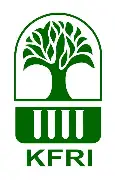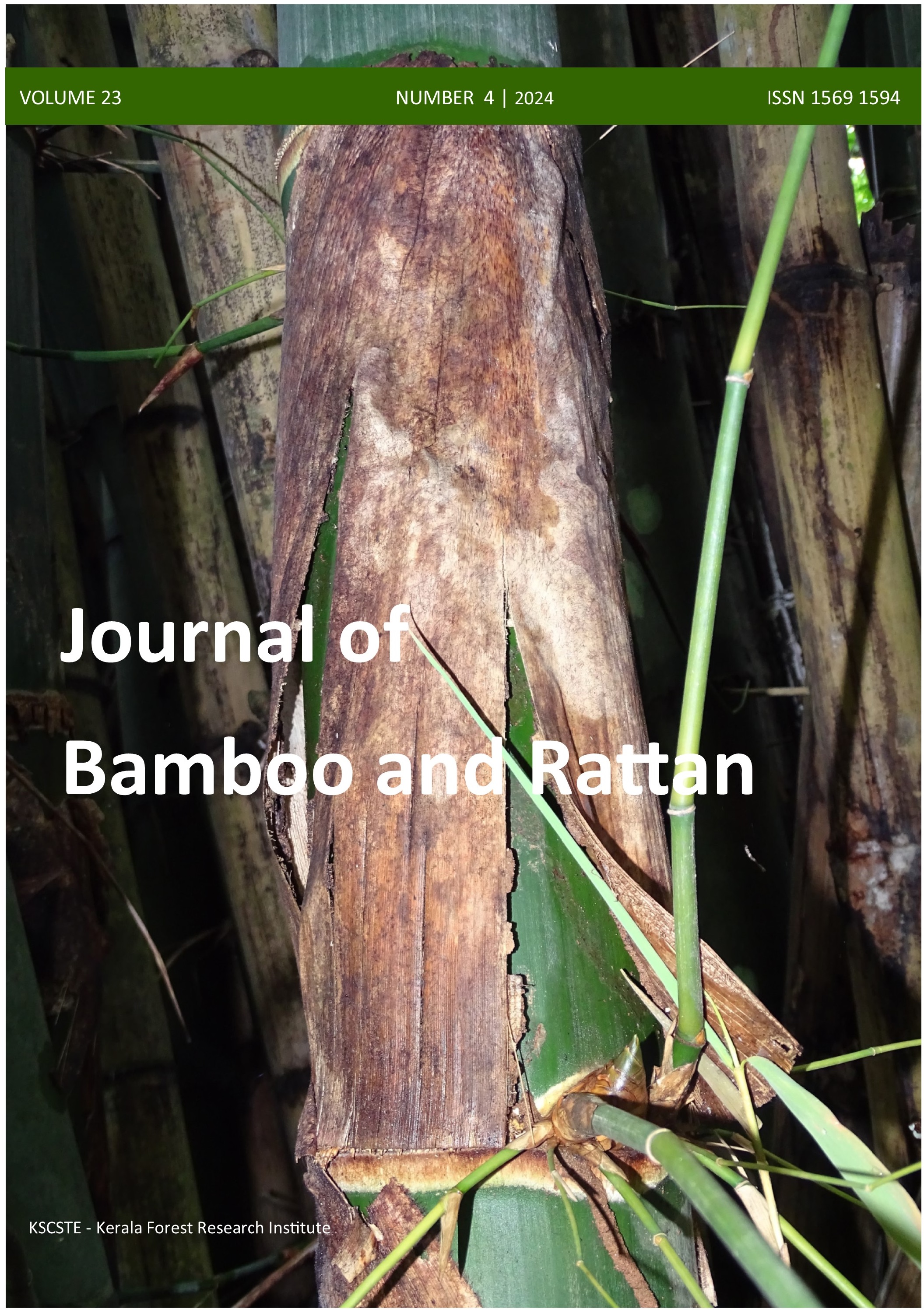Potential bamboo species for cultivation in the southern plateau of Atlantic Forest, Brazil
DOI:
https://doi.org/10.55899/09734449/jbr023402Keywords:
diversification, bamboo uses, diversified systems, ethnobotanical approachesAbstract
In the Atlantic Forest, several native bamboo species have a history of use by local populations, being a source of Non-Timber Forest Products (NTFPs). Later, with the colonization process, the introduction of Asian species increased the diversity of bamboo in use. However, in the Santa Catarina State plateau region, bamboo exploration is still incipient, and in this sense, this study is part of an initiative that aims to generate information for the development of Bamboo productive chain in southern Brazil. This study aimed primarily to identify bamboo species, native and exotic, with potential for cultivation with emphasis on the establishment of diversified production systems. As a first research strategy, seven species were studied in three experimental areas in order to evaluate their adaptability to the conditions of the plateau region of the Santa Catarina State. The second strategy sought to identify bamboo species already in use by family farmers in this region. Based on the results the transition phase of clumps to a mature and harvested state of evaluated bamboo species in this study can take more than three years. In addition, the maintainers interviewed pointed out eight exploited bamboo species, among them Bambusa tuldoides, and two native species from Brazil Chusquea sellowii and Guadua chacoensis. We suggest that the management of bamboo, even native ones, should be done based on environment context and technical strategies, to establish diversified systems balanced with environmental services.
References
Alvares, C.A., Stape, J.L., Sentelhas, P.C., Gonçalves, J.D.M. and Sparovek, G. 2013. Köppen’s climate classification map for Brazil. Meteorologische zeitschrift, 22(6), pp.711-728. DOI:10.1127/09412948/2013/0507
Arunachalam, A. and Arunachalam, K. 2002. Evaluation of bamboos in eco-restoration of ‘jhum’fallows in Arunachal Pradesh: ground vegetation, soil and microbial biomass. Forest Ecology and Management, 159 (3), pp.231-239. https://doi.org/10.1016/S0378-1127 (01)00435-2
Brand, M.A., Balduino Junior, A.L., Nones, D.L. and Gaa, A.Z.N. 2019. Potential of bamboo species for the production of briquettes. Pesquisa Agropecuária Tropical, 49, p.e54178. https://doi.org/10.1590/198340632019v4954178
Brand, M.A., Gaa, A.Z.N., Balduino Junior, A.L., Cunha, A.B.D. and Rios, P.D.A. 2020. Potencial do uso de quatro espécies de bambu para a produção de carvão vegetal para uso doméstico. Ciência Florestal, 30, pp.60-71. https://doi.org/10.5902/1980509827348
Bernacci, L.C., Cervi, A.C., Milward-de-Azevedo, M.A., Nunes, T.S., Imig, D.C. and Mezzonato, A.C. 2015. Passifloraceae in lista de espécies da flora do Brasil.. Jardim Botânico do Rio de Janeiro, 28. http://loradobrasil.jbrj.gov.br/jabot/floradobrasil/FB13116.
Chalopin, D., Clark, L.G., Wysocki, W.P., Park, M., Duvall, M.R. and Bennetzen, J.L. 2021. Integrated genomic analyses from low-depth sequencing help resolve phylogenetic incongruence in the bamboos (Poaceae: Bambusoideae). Frontiers in plant science, 12, p.725728. https://doi.org/10.3389/fpls.20 21.725728
Clark, L.G., Londono, X. and Ruiz-Sanchez, E. 2015. Bamboo taxonomy and habitat. Bamboo: The plant and its uses, pp.1-30. https://doi.org/10.1007/978-3319-14133-6_1
Colwell, R.K. 2006. EstimateS: statistical estimation of species richness and shared species from samples, version 8. purl. oclc. org/estimates.
Drumond, P.M.; Wiedman, G. 2017. Bambus no Brasil: da biologia a tecnologia. https://www.infoteca.cnptia. embrapa.br/infoteca/handle/doc/1078373
Felisberto, M.H.F., Beraldo, A.L. and Clerici, M.T.P.S. 2017. Young bamboo culm flour of Dendrocalamus asper: Technological properties for food applications. LWT-Food Science and Technology, 76, pp.230-235. https://doi.org/10.1016/j.lwt.2016.06.015
Fernandez, E.C., Palijon, A.M., Liese, W., Esguerra, F.L. and Murphy, R.J. 2003. Growth performance of two bamboo species in new plantations. Journal of Bamboo and Rattan, 2(3), pp.225-239.
Filgueiras, T.S. and Viana, P.L. 2017. Bambus brasileiros: morfologia, taxonomia, distribuiçao e conservaçao. Bambus no Brasil: da biologia à tecnologia. Rio de Janeiro: ICH, pp.10-27.
Greco, T.M. and Ríos, H.C. 2011. Bambu: cultivo e manejo. Insular. 181 p.
Larpkern, P., Moe, S.R. and Totland, Ø., 2011. Bamboo dominance reduces tree regeneration in a disturbed tropical forest. Oecologia, 165, pp.161-168. https://
doi.org/10.1007/s00442-010-1707-0
Lima, R.A., Rother, D.C., Muler, A.E., Lepsch, I.F. and Rodrigues, R.R. 2012. Bamboo overabundance alters forest structure and dynamics in the Atlantic Forest hotspot. Biological Conservation, 147(1), pp.32-39. https://doi.org/10.1016/j.biocon.2012.01.015
Lobovikov, M., Ball, L. and Guardia, M. 2007. World bamboo resources: a thematic study prepared in the framework of the global forest resources assessment 2005 (No. 18). Food & Agriculture Org.
Lobovikov, M., Schoene, D. and Yping, L. 2012. Bamboo in climate change and rural livelihoods. Mitigation and Adaptation Strategies for Global Change, 17, pp.261-276. https://doi.org/10.1007/s11027-011-9324-8
Nath, A.J., Lal, R. and Das, A.K. 2015. Managing woody bamboos for carbon farming and carbon trading. Global Ecology and Conservation, 3, pp.654-663. https:// doi.org/10.1016/j.gecco.2015.03.002
Mishra, G., Giri, K., Panday, S., Kumar, R. and Bisht, N.S. 2014. Bamboo: potential resource for ecorestoration of degraded lands. Journal of Biology and Earth Sciences, 4(2), pp.B130-B136.
de Miranda, E.M., Afonso, D.G., de Araújo Pontes, S.M., de Souza, J.C.N., do Nascimento Lima, D. and de Freitas Júnior, J.L., 2017. Estrutura populacional e o potencial de uso de Guadua cf. superba na região do Alto Acre. Bambus no Brasil, p.161.
Ruiz-Sanchez, E., Tyrrell, C.D., Londoño, X., Oliveira, R.P. and Clark, L.G. 2021. Diversity, distribution, and classification of Neotropical woody bamboos (Poaceae: bambusoideae) in the 21st Century. Botanical Sciences, 99(2), pp.198-228. https://doi.org/10.17129/ botsci.2722.
Sanquetta, C.R., Côrte, A.P.D., Roglin, A. and Mognon, F. 2015. Biomassa individual de Bambusa oldhamii Munro e Bambusa vulgaris Schrad. ex JC Wendl. Cerne, 21, pp.151-159. https://doi.org/10.1590/01047760201521011483
Sanquetta, C.R., Mognon, F., Dalla Corte, A.P., de Novaes, A.B. and Blum, C.T. 2017. Em busca de características promissoras: avaliação experimental de seis espécies de bambu em Pinhais (PR). Bambus no Brasil, p.270.
Santos, H.G.; Jacomine, P.K.T.; Anjos, L.H.C.; Oliveira, V.A.; Lumbreras, J.F.; Coelho, M.R.; Almeira, J.A.; Araújo Filho, J.C.; Oliveira, J.B.; Cunha, T.J.F. 2018. Sistema Brasileiro de Classificação de Solos. Embrapa: Brasília. 355 p.
Sharma, R., Wahono, J. and Baral, H. 2018. Bamboo as an alternative bioenergy crop and powerful ally for land restoration in Indonesia. Sustainability, 10(12), p.4367. https://doi.org/10.3390/su10124367
Vorontsova, M.S., Clark, L.G., Dransfield, J., Govaerts, R. and Baker, W.J. 2016. World checklist of bamboos and rattans. https://kew.iro.bl.uk/concern/books/5
bee1ffc-a641-4739-9d38-590d7ebb71af
Wrege, M.S., Steinmetz, S.; Reisser Junior, I.R.; Almeira, J. 2011. Atlas climático da Região Sul do Brasil: Estados do Paraná, Santa Catarina e Rio Grande do Sul. http://www.alice.cnptia.embrapa.br/alice/handle/ doc/1167632
Downloads
Published
Issue
Section
License
Copyright (c) 2025 Journal of Bamboo and Rattan

This work is licensed under a Creative Commons Attribution-NonCommercial-ShareAlike 4.0 International License.
How to Cite
Similar Articles
- Jithu Unni Krishnan, Prabhat Kumar, Sreekumar V.B., Surya Narayanan G.K., Bheemalingappa M., In-Vitro Assessment of Host Suitability of Thirty-One Bamboo Species to the Invasive Polyphagous Pest Spodoptera frugiperda (J.E. Smith) (Lepidoptera: Noctuidae) , Journal of Bamboo and Rattan: Vol. 23 (2024): Issue 4
- Juan Francisco Aguirre-Cadena, Juan Francisco Aguirre-Medina, Jose Luis Lopez-Gonzalez, Nidia Belgica Pérez-De la O, Social and economic importance of new bamboo species established in three municipalities of the North Eastern Mountain range of Puebla, Mexico , Journal of Bamboo and Rattan: Vol. 22 (2023): Issue 2
- E. Appiah-Kubi, F. W. Owusu, S. L. Tekpetey , C. Essien, Bamboo for housing in Ghana: challenges and prospects for the future , Journal of Bamboo and Rattan: Vol. 13 (2014): Issue 3 & 4
- Thiti Wanishdilokratn, Jirapa Wanishdilokratn, Physical and mechanical properties of Dendrocalamus giganteus from difference zones in Long district, Phrae province, Thailand , Journal of Bamboo and Rattan: Vol. 23 (2024): Issue 2
- Koranat Narkpiban, Piangkhwan Kruapoo, Rangsan Koodsamrong, Chaiyasit Keawcharoon, Najjapak Sooksawat, Characterization and property evaluation of low-cost electrically conductive bamboo charcoal from Dendrocalamus sericeus Munro. , Journal of Bamboo and Rattan: Vol. 22 (2023): Issue 1
- Shweta B. Kukreti, Aswathi Rajeev, Review on bamboo treatment in India: A species-specific approach for enhanced durability , Journal of Bamboo and Rattan: Vol. 23 (2024): Issue 1
- E. Appiah-Kubi, F.W. Owusu, S. L. Tekpetey, C. Essien, H. Seidu , Investigating the mechanical properties of some bamboo species for efficient utilization in Ghana , Journal of Bamboo and Rattan: Vol. 13 (2014): Issue 3 & 4
- Rajesh Tamang, Dr. Sanjeev Kumar Rai, Prof. Dr. Sangeeta Rajbhandary, Diversity and morphology of bamboo species in Nepal , Journal of Bamboo and Rattan: Vol. 24 (2025): Issue 1
- T. Peprah, C. Essien, K. Owusu-Afriyie, E. G. Foli, J. Govina , A. A. Oteng-Amoako, Exploring the use of bamboo for accelerated reclamation of degraded mined sites in Ghana , Journal of Bamboo and Rattan: Vol. 13 (2014): Issue 3 & 4
- F.W. Owusu, E. Appiah-Kubi, S.L. Tekpetey, C. Essien, P. I. Arthur, G. K. Zorwe, Products development of laminated panel doors from plantation grown bamboo species in Ghana , Journal of Bamboo and Rattan: Vol. 13 (2014): Issue 3 & 4
You may also start an advanced similarity search for this article.

